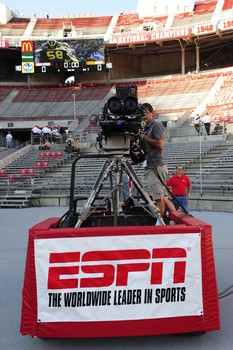ESPN's 3DTV Is An 'Ongoing Science Project'
ESPN will be in experimentation mode with 3DTV over the next six months, looking at different technologies and production techniques leading up to the launch of what it's billing as the industry's first 3D network this summer.
"This is an ongoing science project for us," said Bryan Burns, ESPN's vice president of strategic business planning and development.
ESPN kicked off its 3D efforts in a concerted way about a year ago, creating the 3DOC -- "3D organizing committee" -- which comprises about 30 people, Burns said.
On Tuesday, the programmer announced the culmination of the 3DOC's work: a 3D service set to debut this summer with the June 11 World Cup match featuring South Africa vs. Mexico. The service is scheduled to include at least 85 live events in the first year, including college football, college basketball and National Basketball Association games.

But ESPN 3D will not be a 24-hour service: It will be on the air only when a live 3D event is being broadcast, and otherwise dark. "Out of respect to the bandwidth needs of our distributors... we're going to take it down after the event," Burns said.
ESPN has not announced any carriage deals for the new network; Burns declined to say whether ESPN 3D would be available as a premium channel or through a sports tier. DirecTV, for its part, has expressed interest in 3DTV in general and the cable industry -- through CableLabs -- has undertaken an initiative to lay the technical groundwork for 3D broadcasts.
ESPN's lineup of events to be delivered in 3D include up to 25 World Cup matches, ESPN's Summer X Games in Los Angeles, college basketball and college football, including the BCS National Championship game in Glendale, Ariz., January 10, 2011.
Multichannel Newsletter
The smarter way to stay on top of the multichannel video marketplace. Sign up below.
ESPN is now in discussions with production truck vendors to obtain a vehicle for the approximately 60 3D broadcasts it has scheduled for North America, Burns said. Included in those discussions are technical facilities to produce the 3D telecasts, he added: "We're close on vendors."
Initially, ESPN will need completely separate production crews and facilities for regular HD broadcasts and the 3D versions. Burns said one of the things ESPN will be examining in the next few months will be how to render a 2D HD feed from one of the sides of a 3D telecast.
Home viewers will need to wear some kind of glasses and have a 3D-compatible TV, but ESPN has not determined which specific stereoscopic format it will use for 3D broadcasts. Burns said decisions on formats "will be made very, very soon," and he noted that ESPN staff are represented on different technical committees that are hammering out standards, including the Society of Motion Picture and Television Engineers' task force on 3D to the home.

"We think there will be a virtual tsunami of announcements from CE makers with new 3DTVs, and we're getting ahead of that and working with them to drive products into the marketplace," Burns said. "We've seen where 3D can enhance certain sports events."
Burns compared the development of ESPN's 3D network to its HD launch, which was announced in September 2002. "If we had a big three-ring binder that we had produced seven years ago, all the tabs are exactly the same," he said. He declined to provide an estimate for how much ESPN is spending on the 3D initiative.
ESPN HD, he pointed out, started with "two and a half" production trucks -- because ABC Monday Night Football used one for half the year. Now, ESPN has about 90 HD trucks on the road.
On the 3D front, ESPN has been testing the technology for more than two years. Last fall, ESPN produced a 3D broadcast of the University of Southern California vs. Ohio State University football game, which was shown in select theaters.
Meanwhile, Discovery Communications, Sony and IMAX are teaming up for a 24-hour linear 3D service to launch in 2011.
Discovery and ESPN were the first two networks to dip their toes into HD -- and it took several years for viewers to arrive in significant quantities, Bruce Leichtman, president and Principal Analyst of the Leichtman Research Group.
"Did they have tremendous success [with HD]? Not necessarily at first," Leichtman said. "But when it started taking off, they were in a position to succeed. Those companies learned that being the leader has its advantages."
